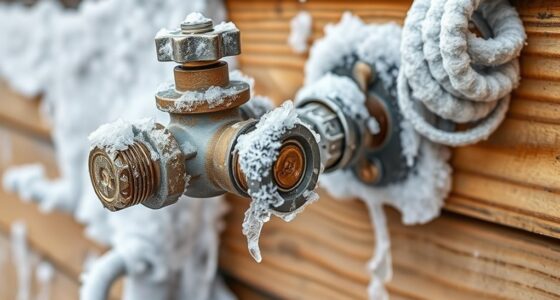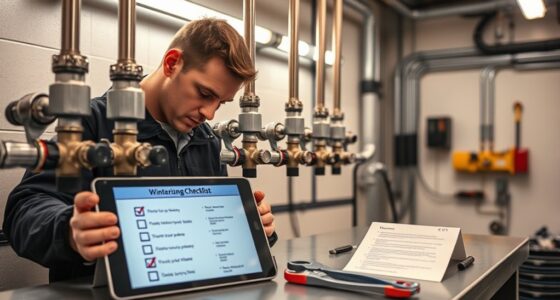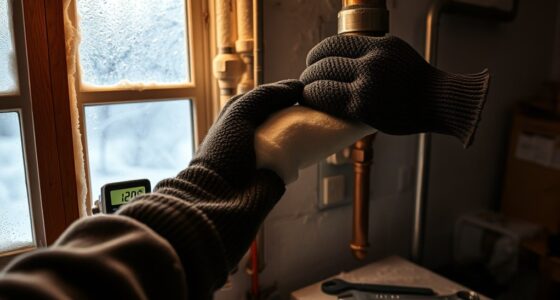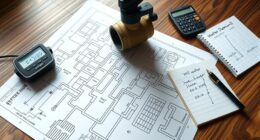To build confidence in your drain and discharge options, start by evaluating your site’s conditions, including topography, wastewater volume, and proximity to water bodies. Choose appropriate methods like surface drainage or subsurface systems, ensuring they’re safe and compliant with regulations. Use corrosion-resistant materials and plan for future land changes. Incorporate safety features and sustainable practices to protect the environment. Keep exploring these key aspects to develop a reliable, efficient drainage system tailored to your needs.
Key Takeaways
- Assess site-specific conditions to select appropriate drainage methods, considering landscape, volume, and future growth.
- Prioritize safety by choosing corrosion-resistant materials and designing accessible, maintenance-friendly components.
- Match drainage options, such as surface ditches or subsurface systems, to runoff volume and space constraints.
- Ensure compliance with local regulations, permits, and environmental standards throughout system planning and implementation.
- Incorporate sustainable practices and scalable features for adaptability and minimal ecological impact over time.
Essential Guide to Drain and Discharge System Planning
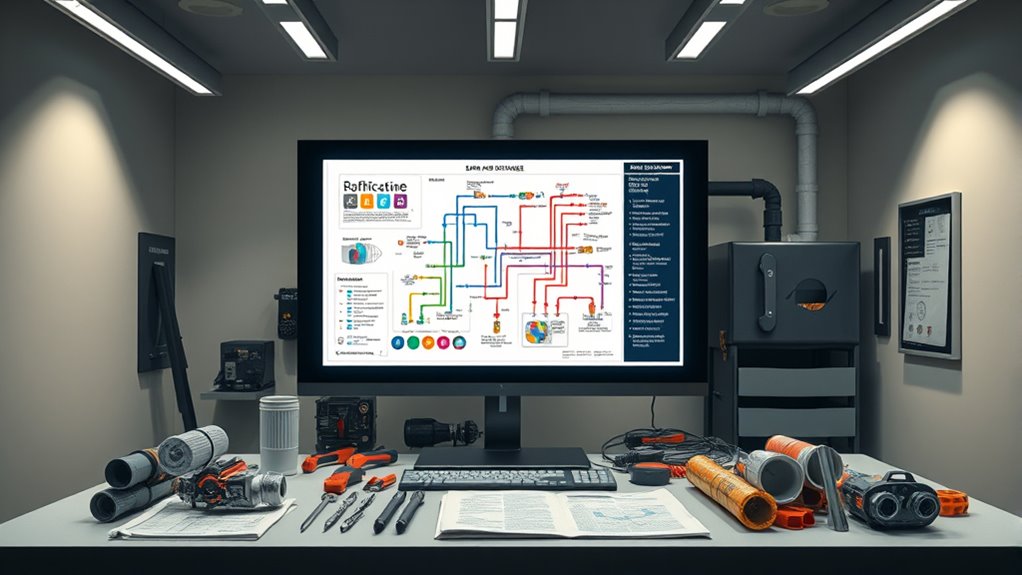
When considering drain and discharge options, it is essential to choose methods that effectively redirect wastewater while complying with local regulations. Your first step is to pay close attention to system design, guaranteeing it’s tailored to your specific needs and site conditions. A well-thought-out system design helps prevent backups, leaks, and overflows, reducing potential environmental harm and costly repairs. You’ll want to evaluate the volume of wastewater generated, the landscape’s topography, and the proximity to water bodies or sensitive areas. Proper planning guarantees that your drainage system operates smoothly and reliably.
Safety considerations should be at the forefront of your decision-making process. When installing drain and discharge systems, you must prioritize safety protocols to protect both the environment and your community. This includes selecting materials resistant to corrosion and chemical breakdown, which reduces the risk of leaks and contamination. Additionally, making sure your system has appropriate access points for maintenance and inspections is essential. Regular checks can identify issues early, preventing larger failures that could pose health hazards or environmental risks.
Prioritize safety by choosing corrosion-resistant materials and ensuring accessible maintenance points.
You’ll also need to consider the types of discharge options available. Surface drainage methods like ditches and swales are suitable for large volumes of water and can be integrated into your landscape design. Subsurface solutions, such as French drains or seepage pits, are better for areas where surface runoff needs to be minimized or where space is limited. Each option has its own safety considerations—some may require extra reinforcement or protective barriers to prevent accidental damage or unauthorized access. Incorporating proper system design ensures all components work together effectively and sustainably.
Another key aspect is understanding the local regulations governing wastewater discharge. These rules dictate acceptable methods, discharge limits, and necessary permits. Ignoring these regulations can lead to hefty fines and environmental penalties. Consequently, you should consult with local authorities or environmental specialists during your planning process. They can help you design a compliant system that meets safety standards and regulatory requirements.
Finally, think about future scalability and environmental impacts. A good system design considers potential growth or changes in land use, ensuring your drainage solution remains effective over time. Incorporate features that facilitate easy upgrades or modifications, and plan for sustainable practices that minimize ecological footprints. By integrating safety considerations into every stage of your system design, you’re guaranteeing a reliable, compliant, and environmentally responsible drainage and discharge setup that you can trust for years to come.
Frequently Asked Questions
How Do I Determine the Best Discharge Method for My Facility?
To determine the best discharge method for your facility, start with thorough discharge design and facility planning. Assess your waste volume, type, and local regulations. Consider factors like space, environmental impact, and safety. Consult with experts to evaluate options such as gravity, pump, or specialized systems. This approach guarantees you select a discharge method that’s efficient, compliant, and tailored to your facility’s specific needs.
What Safety Precautions Are Necessary During Drain Installation?
Oh, yes, safety first—because installing drains is just as perilous as defusing a bomb, right? You’ll want to don proper personal protective equipment, like gloves and goggles, to fend off splashes and debris. Also, make certain an emergency shutdown procedure is in place before starting. This way, if things go awry, you can quickly cut power and prevent mishaps, keeping everyone safe and your project on track.
How Often Should Drain and Discharge Systems Be Inspected?
You should inspect your drain and discharge systems at least annually, following recommended maintenance schedules. Use inspection techniques like visual checks for leaks, blockages, or corrosion, and perform flow tests to guarantee proper function. Regular inspections help catch issues early, preventing costly repairs and ensuring safety. Adjust your maintenance frequency based on usage and environmental factors, and document all inspections to keep track of system performance over time.
Are There Specific Regulations for Hazardous Waste Discharge?
They say, “Knowledge is power,” and that’s true for hazardous waste discharge regulations. You must follow specific rules based on waste classification to make certain environmental compliance. Regulations vary by location and waste type, often requiring permits, proper storage, and discharge limits. Failing to adhere can lead to hefty fines. Always stay updated on local, state, and federal laws to keep your operations safe and compliant.
What Are Common Troubleshooting Steps for Discharge System Blockages?
You should start troubleshooting discharge system blockages by checking airflow management to guarantee nothing is obstructing proper airflow, which can cause backups. Next, inspect your pump maintenance routines, looking for clogs or wear that could impede function. Clear any debris, verify connections, and test the system’s operation. Regularly maintaining airflow and pump components prevents future blockages, keeping your discharge system running smoothly and efficiently.
Conclusion
Now that you’ve explored these drain and discharge options, you’re better equipped to navigate your project with confidence. Remember, every system has its nuances, and choosing the right approach can gently guide your efforts toward success. Trust your instincts, stay attentive to details, and you’ll find the perfect balance. With a thoughtful plan in place, you’ll smoothly steer your journey from uncertainty to assured accomplishment.


